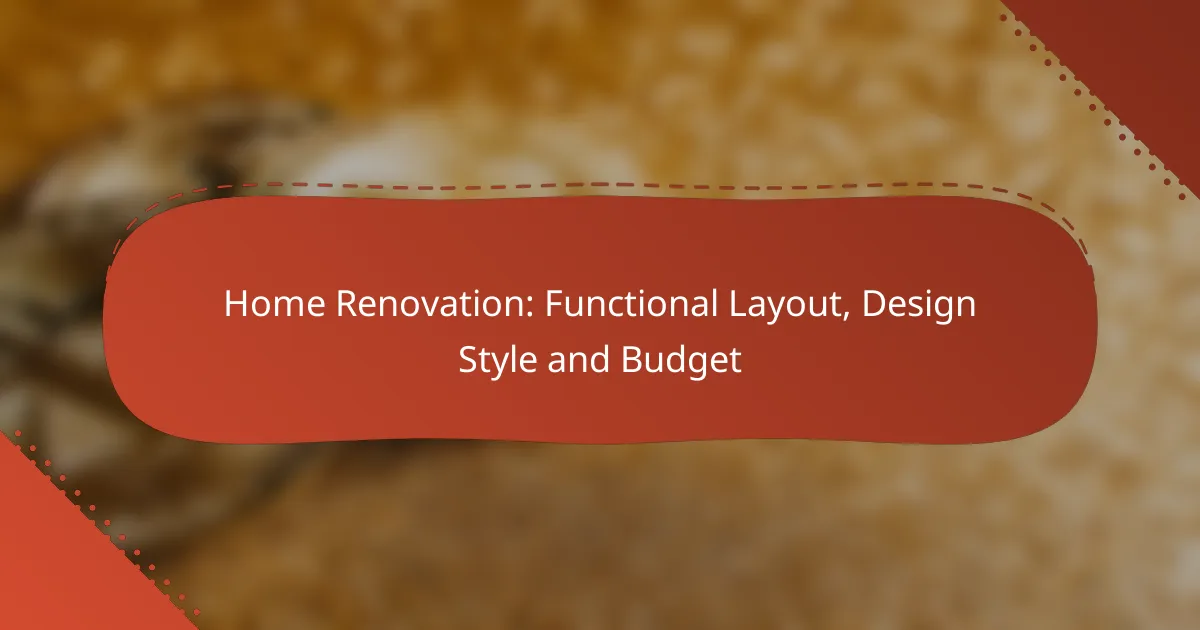Home renovation is an opportunity to transform your living space into a more functional and aesthetically pleasing environment. By focusing on a thoughtful layout, selecting a design style that resonates with your personal taste, and adhering to a budget, you can create a home that meets your family’s needs while enhancing its overall value. Consider incorporating modern elements such as energy-efficient upgrades and smart technology to elevate both comfort and efficiency.

What are the best home renovation solutions in Los Angeles?
The best home renovation solutions in Los Angeles focus on maximizing space, enhancing energy efficiency, and incorporating modern technology. Homeowners should consider open layouts, energy-efficient upgrades, and smart home features to increase functionality and value.
Open floor plans
Open floor plans are popular in Los Angeles for creating a spacious and inviting atmosphere. This design removes barriers between living areas, allowing for better flow and natural light. When considering an open layout, think about how to maintain distinct zones for cooking, dining, and lounging without sacrificing cohesion.
To implement an open floor plan, consider removing non-load-bearing walls and using furniture to define spaces. This approach can enhance the overall aesthetic and functionality of your home, making it ideal for both family living and entertaining guests.
Energy-efficient upgrades
Energy-efficient upgrades are essential for reducing utility bills and increasing home comfort in Los Angeles. Key improvements include installing high-efficiency windows, upgrading insulation, and using Energy Star-rated appliances. These upgrades not only lower energy consumption but may also qualify for local rebates or tax incentives.
When planning energy-efficient renovations, assess your current energy usage and prioritize upgrades that offer the best return on investment. For instance, replacing old HVAC systems can significantly enhance comfort and efficiency, often recouping costs through lower energy bills.
Smart home technology integration
Integrating smart home technology can enhance convenience and security in your Los Angeles home. Popular options include smart thermostats, lighting systems, and security cameras that can be controlled remotely via smartphone apps. These technologies not only improve daily living but can also increase your home’s market appeal.
When choosing smart devices, consider compatibility with existing systems and ease of use. Start with a few key devices that address your specific needs, such as a smart thermostat to optimize heating and cooling, and expand from there as your budget allows.
Outdoor living spaces
Outdoor living spaces are a valuable addition to homes in Los Angeles, allowing residents to enjoy the pleasant climate. Consider features like patios, decks, or outdoor kitchens that extend your living area and provide a space for relaxation and entertainment. These enhancements can significantly increase your home’s value and appeal.
When designing outdoor spaces, think about functionality and aesthetics. Use durable materials that can withstand the local climate, and incorporate landscaping elements that enhance the overall look while providing shade and privacy.
Custom cabinetry
Custom cabinetry offers tailored solutions that maximize storage and enhance the design of your home. In Los Angeles, where space can be limited, custom cabinets can be designed to fit specific dimensions and styles, ensuring optimal use of available space. This can be particularly beneficial in kitchens and bathrooms.
When investing in custom cabinetry, work with a skilled designer to create functional and stylish solutions that meet your needs. Consider materials, finishes, and hardware that complement your overall design theme while ensuring durability and ease of maintenance.

How to choose a functional layout for your home?
Choosing a functional layout for your home involves understanding your family’s needs, analyzing traffic flow, and considering room adjacency. A well-planned layout enhances daily living and maximizes space efficiency.
Assessing family needs
Start by evaluating the specific requirements of your family members. Consider factors such as the number of occupants, their ages, and lifestyle preferences. For instance, families with young children may prioritize open spaces for play, while those with older adults might need accessible features.
Engage all family members in discussions to gather insights on their daily routines and preferences. This collaborative approach ensures that the layout accommodates everyone’s needs, promoting harmony and functionality.
Traffic flow analysis
Traffic flow refers to how people move through your home and is crucial for a functional layout. Identify high-traffic areas, such as entrances, hallways, and kitchens, and ensure these spaces are unobstructed and easy to navigate. Aim for clear pathways that allow for smooth transitions between rooms.
Consider the placement of furniture and fixtures to avoid bottlenecks. For example, in a kitchen, ensure that the refrigerator, sink, and stove are arranged in a way that facilitates efficient movement, often referred to as the work triangle.
Room adjacency considerations
Room adjacency plays a significant role in creating a cohesive and functional layout. Think about how different spaces relate to one another; for instance, placing the dining room near the kitchen can streamline meal service and enhance social interactions.
Additionally, consider noise levels and privacy. Bedrooms should be situated away from high-traffic areas to minimize disturbances, while communal spaces like living rooms should be easily accessible. This strategic placement enhances both convenience and comfort in your home.

What design styles are popular for home renovations?
Popular design styles for home renovations include modern minimalist, farmhouse chic, mid-century modern, and industrial style. Each of these styles offers unique aesthetics and functional benefits, allowing homeowners to choose based on personal preference and lifestyle needs.
Modern minimalist
Modern minimalist design emphasizes simplicity and functionality, often featuring clean lines and a neutral color palette. This style focuses on decluttering spaces, using only essential furnishings and decor to create a serene environment.
When considering a modern minimalist renovation, prioritize open floor plans and natural light. Use materials like glass, metal, and wood to enhance the sleek look while maintaining warmth.
Farmhouse chic
Farmhouse chic combines rustic charm with modern elements, creating a cozy and inviting atmosphere. This style often includes features like shiplap walls, vintage decor, and a mix of textures, such as wood and metal.
To achieve a farmhouse chic look, incorporate reclaimed wood furniture and soft, neutral fabrics. Consider adding a large farmhouse sink or open shelving in the kitchen to enhance the aesthetic.
Mid-century modern
Mid-century modern design is characterized by its retro appeal and functional form, featuring organic shapes and vibrant colors. This style often includes iconic furniture pieces and large windows that connect indoor and outdoor spaces.
For a mid-century modern renovation, focus on integrating bold colors and geometric patterns. Look for furniture with tapered legs and low profiles to capture the essence of this timeless style.
Industrial style
Industrial style draws inspiration from warehouses and factories, showcasing raw materials like exposed brick, metal, and concrete. This design often features open spaces and a mix of vintage and modern furnishings.
To create an industrial look, consider using pendant lighting and metal fixtures. Keep walls bare and incorporate large, open spaces to highlight the structural elements of your home.

What is the average budget for home renovations in major cities?
The average budget for home renovations varies significantly across major cities, often ranging from low tens of thousands to over a hundred thousand USD, depending on the scope and complexity of the project. Key factors influencing these costs include local labor rates, material prices, and the specific renovations being undertaken.
Los Angeles renovation costs
In Los Angeles, renovation costs typically range from about $20,000 to $150,000, depending on the size of the home and the extent of the renovations. Kitchen and bathroom remodels tend to be the most expensive, often costing upwards of $30,000 each.
Homeowners should consider local regulations and permits, which can add to the overall budget. Hiring licensed contractors is crucial to ensure compliance with California’s stringent building codes.
New York City renovation costs
New York City sees renovation budgets that can start around $30,000 and soar to over $200,000 for larger projects. The high cost of living in NYC significantly impacts labor and material expenses, making it one of the most expensive cities for renovations.
It’s essential to factor in additional costs such as permits and potential building management fees, especially in co-ops and condos. Engaging with experienced professionals familiar with NYC regulations can help streamline the process.
Chicago renovation costs
In Chicago, renovation costs generally range from $15,000 to $100,000, with kitchen and bathroom upgrades being the most common projects. The city’s diverse housing stock means that costs can vary widely based on the age and condition of the property.
Homeowners should be aware of local zoning laws and permit requirements, which can influence timelines and budgets. Working with local contractors can provide insights into cost-effective solutions tailored to the Chicago market.

What factors influence home renovation budgets?
Home renovation budgets are influenced by various factors, including material choices, labor costs, and the overall scope of the project. Understanding these elements can help homeowners plan effectively and avoid unexpected expenses.
Material choices
The selection of materials significantly impacts the overall renovation budget. High-quality materials, such as natural stone or premium hardwood, can elevate costs, while more affordable options like laminate or vinyl can help keep expenses down.
When choosing materials, consider not only the upfront costs but also the long-term value and maintenance requirements. For example, investing in durable materials may save money on repairs and replacements in the future.
Labor costs
Labor costs can vary widely based on the complexity of the renovation and the local market rates. Skilled tradespeople, such as electricians and plumbers, often charge higher rates than general contractors, so it’s essential to budget accordingly.
To manage labor expenses, obtain multiple quotes and consider the timing of your renovation. Off-peak seasons may offer lower labor costs, and planning the project efficiently can reduce the overall labor hours required.
